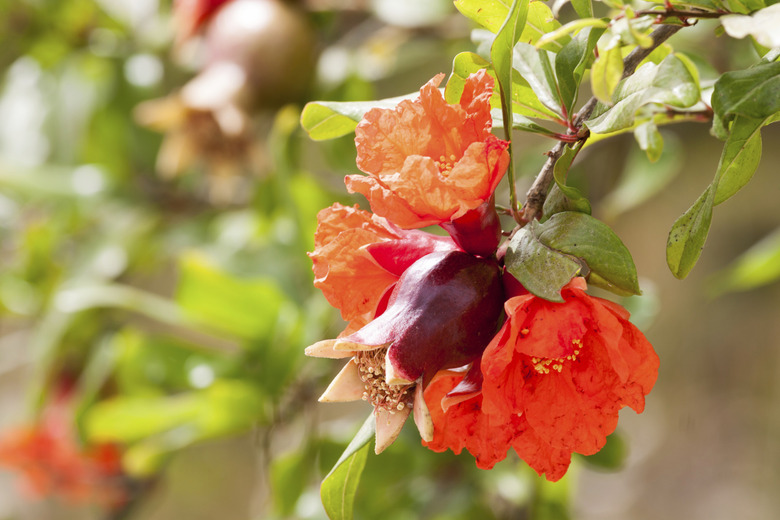When Do Pomegranate Trees Bloom?
Young pomegranate trees (Punica granatum) produce scattered blossoms during their first few years, but the trees flower in earnest once they reach 3 to 4 years old. When that time arrives, flowering occurs from midspring into fall, with several cycles of heavy early blooms and fruit set. While you can enjoy pomegranate's fiery flowers, it's the fruit that follows that really adds beauty and flavor. Understanding pomegranate blooms can help increase fruits.
Inside Pomegranate Flowers
Pomegranates are what botanists call monoecious plants. This means that both male and female reproductive organs are represented in the flowers. In pomegranates, this happens through two different flower types: imperfect single-sex, male flowers and perfect blooms that have both male and female parts. Clustered together at branch tips, the blooms sit in thick, fleshy calyxes that later become the fruit's skin.
The vase-shaped male flowers produce pollen, but not fruit. The urn-shaped perfect flowers hold pollen-producing male stamens as well as fruit-producing female pistils. The calyx's full, bulbous bottom reflects the ovary inside.
Bloom Patterns and Cycles
Most of a pomegranate's fruit-producing flowers bloom in the first three months of spring. Blooming may happen continuously or come in continual flushes, depending on growing conditions and the tree itself.
Fruit can set with each cycle of bloom, with the earliest blooms producing the largest fruits. Flowers borne throughout summer into fall also produce fruit, but the pomegranates are much smaller and may not be as tasty.
All pomegranate varieties flower on the same basic schedule with minimal variation, but varieties differ in the time fruits take to ripen. Pomegranate trees decline in flowering and productivity after approximately 15 years.
Factors That Enhance Blooming
True to their heritage, pomegranate trees flourish in cool winters and hot, dry summers characteristic of Mediterranean-type climates. Able to withstand winters in U.S. Department of Agriculture plant hardiness zones 7b through 11, pomegranates rely on full, direct sun for maximum blooms and fruit. Humidity inhibits flowering, causing blooms to fail or drop prematurely, so good air circulation is important.
Established pomegranate trees produce best with minimal or no pruning. Because flowers and their fruit form on new branch tips, pruning anytime during active growth reduces productivity.
Pollination and Fruit That Follows
Pomegranate flowers can pollinate themselves, pollinate other blossoms on the same tree or cross-pollinate with neighboring pomegranates. Cross-pollination, aided by insect pollinators, usually yields larger harvests. Female blooms remain receptive for just two to three days, and wind offers little help.
When blooms wane, the window closes. Male flowers and unfertilized perfect blossoms fall to the ground. Pollinated blooms stay on the tree and grow. The bulbous base grows large and redder, as the calyx forms pomegranate's distinctive crown.
Fruits ripen five to seven months after pollination. The long-lasting bloom cycles lead to extended harvests. Ripe pomegranates and striking fall blooms often appear side by side.
